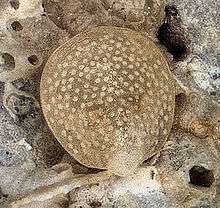Gwynia
Gwynia capsula is a very small to minute brachiopod (maximally 1.5 millimetres or 0.059 inches long), currently known from the east Atlantic (France, Belgium, British Isles)[2], but which occurred during the Pleistocene in what is now Norway. It has a translucent, whitish, purse-shaped shell with relatively large, wide-spaced pits (or punctae). It lives attached to stones or shells (fragments) in between large grains of sand. Like in all brachiopods, it filters food particles, chiefly diatoms and dinoflagellates. Gwynia capsula harbors a small number of larvae inside a brood pouch, but it has separate sexes, unlike also very small and pouch brooding Argyrotheca and Joania, which are hermaphrodite.[3]
| Gwynia capsula | |
|---|---|
 | |
| Gwynia capsula, 1mm | |
| Scientific classification | |
| Kingdom: | |
| Phylum: | |
| Subphylum: | |
| Class: | |
| Order: | |
| Suborder: | |
| Superfamily: | Megathyridoidea |
| Family: | Megathyrididae |
| Genus: | Gwynia King, 1859 |
| Species: | G. capsula Jeffreys, 1859[1] |
| Synonyms | |
|
Terebratula capsula | |
References
- Jeffreys J. G. (1859). "Further gleanings in British Conchology". Annals and Magazine of Natural History (series 3). 3:30–43, 106–120, pl. 2.
- Voskuil, R. P. A. (2004). De Recente en Tertiaire Brachiopoden van het Nederlandse strand: een inventarisatie van de literatuur en commentaar op het vermeende voorkomen van Gwynia capsula (Jeffreys, 1859) in Zeeuws-Vlaanderen. Het Zeepaard 64(2):45-58
- Moore, R.C. (1965). Brachiopoda. Treatise on Invertebrate Paleontology. Part H., Volume 2. Boulder, Colorado/Lawrence, Kansas: Geological Society of America/University of Kansas Press. pp. H831-32. ISBN 0-8137-3015-5.
This article is issued from Wikipedia. The text is licensed under Creative Commons - Attribution - Sharealike. Additional terms may apply for the media files.